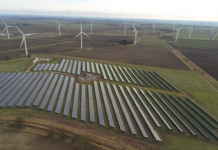Statera has signed a deal with MAN for the 300MW of fast ramping gas peaking plant that it claims are as efficient as some of the UK’s large gas-fired power stations – and more efficient for short run operations.
The company thinks their flexibility represent a better bet than combined cycle gas turbines (CCGTs) and will enable a power system dominated by renewables at a lower cost.
Will anyone build more CCGTs?
SSE has broken ground on its 840MW Keadby 2 CCGT and Drax this month secured planning permission to convert two generating units to deliver up to 3.6GW of CCGT-derived power, though it has yet to make a final investment decision.
Statera managing director, Tom Vernon, said the company has not ruled out building CCGTs, but thinks smaller, flexible engines that can ramp up quickly are more suitable to balance renewable generation.
“You can build a business case to say that the most efficient CCGT on the market can run almost as baseload. We have looked at CCGTs and continue to do so,” he said. “But we are quite clear that in our view of the future market, highly efficient gas recips are the way to go.”
Statera will install the 24 new engines from MAN into six 50MW power plants over the next 18 months. The company intends to build a 1GW portfolio, including battery storage, that will become part of Statkraft’s multi gigawatt virtual power plant.
Vernon said the 150MW of storage “constructed or under construction” by Statera is effective for shorter-term flexibility requirements. But he points to analysis by Aurora that suggests the GB system, if reliant purely on storage, would need huge volumes to balance a largely renewable power system in 2050.
In a net zero system, Aurora believes some 50TWh of dispatchable generation will be required at any one time. Efficient peakers, it suggests, are the most cost effective way to provide that back-up for several hours at a stretch.
“We fundamentally believe in the need for flexible technologies and gas in particular to sit alongside renewables,” said Vernon, suggesting the MAN engines deliver “five to six percentage points of efficiency” over its 50MW Creyke Beck plant, one of the most efficient peakers within the GB market. That makes them “comparable to the efficiency of incumbent CCGTs,” he claimed. “It is a step change in efficiency.”
Compatible with net zero?
Vernon said the MAN engines can “run on synthetic natural gas today” as well as a blend of hydrogen. Vernon added that Statera is “discussing the roadmap with our suppliers to 100 per cent hydrogen”, but that switch would need to come later.
“We are preparing ourselves for net zero to come earlier than 2050,” he said. “We are not just investing because we think [the engines’] useful life will end before 2050.”
Related stories:
Statkraft strikes 1GW VPP deal with Statera
Statkraft: When is a VPP not a VPP?
Statkraft plans 2GW UK virtual power plant by summer
Follow us at @EnergystMedia. For regular bulletins, sign up for the free newsletter.




Amazed that you publish this as fact without any qualification. eg the MAN press release says
“the Statera plants can reach full capacity from standby within around five minutes (versus 60 minutes minimum for a CCGT) and their design has been optimised to be the most efficient way of turning natural gas to electricity for short runs of four hours or less. Analysis conducted by Aurora Energy Research predicts that the most common duration requirement for back-up power to support the renewable energy mix by 2050 will be for under four hours”
So more efficient probably means for a 4 hour run with start-up and shut down inefficiency. A little bit different to your report
That’s true, though qualified in the first sentence – ‘for short run operations’.